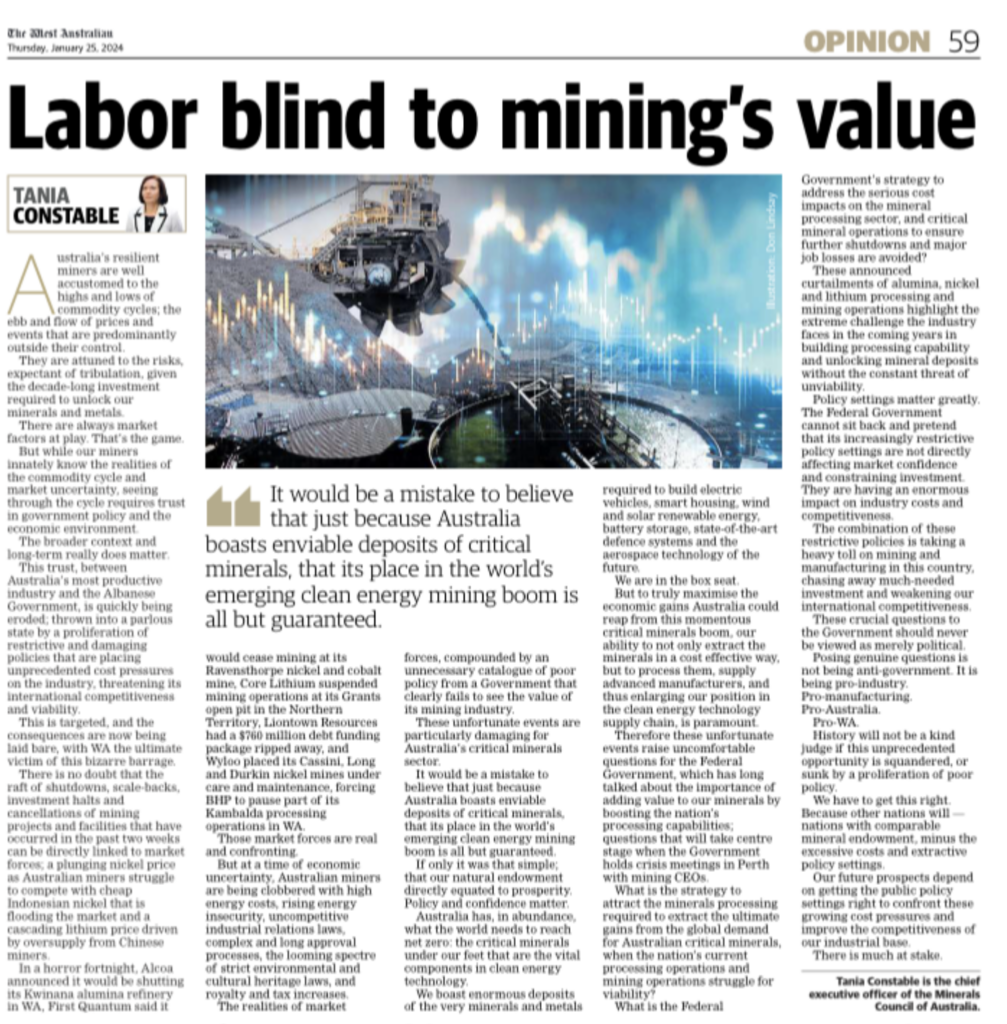

Article by Tania Constable courtesy of the West Australian.
Australia’s resilient miners are well accustomed to the highs and lows of commodity cycles; the ebb and flow of prices and events that are predominantly outside their control.
They are attuned to the risks, expectant of tribulation, given the decade-long investment required to unlock our minerals and metals.
There are always market factors at play. That’s the game.
But while our miners innately know the realities of the commodity cycle and market uncertainty, seeing through the cycle requires trust in government policy and the economic environment.
The broader context and long-term really does matter.
This trust, between Australia’s most productive industry and the Albanese Government, is quickly being eroded; thrown into a parlous state by a proliferation of restrictive and damaging policies that are placing unprecedented cost pressures on the industry, threatening its international competitiveness and viability.
This is targeted, and the consequences are now being laid bare, with WA the ultimate victim of this bizarre barrage.
There is no doubt that the raft of shutdowns, scale-backs, investment halts and cancellations of mining projects and facilities that have occurred in the past two weeks can be directly linked to market forces; a plunging nickel price as Australian miners struggle to compete with cheap Indonesian nickel that is flooding the market and a cascading lithium price driven by oversupply from Chinese miners.
In a horror fortnight, Alcoa announced it would be shutting its Kwinana alumina refinery in WA, First Quantum said it would cease mining at its Ravensthorpe nickel and cobalt mine, Core Lithium suspended mining operations at its Grants open pit in the Northern Territory, Liontown Resources had a $760 million debt funding package ripped away, and Wyloo placed its Cassini, Long and Durkin nickel mines under care and maintenance, forcing BHP to pause part of its Kambalda processing operations in WA.
Those market forces are real and confronting.
But at a time of economic uncertainty, Australian miners are being clobbered with high energy costs, rising energy insecurity, uncompetitive industrial relations laws, complex and long approval processes, the looming spectre of strict environmental and cultural heritage laws, and royalty and tax increases.
The realities of market forces, compounded by an unnecessary catalogue of poor policy from a Government that clearly fails to see the value of its mining industry.
These unfortunate events are particularly damaging for Australia’s critical minerals sector.
It would be a mistake to believe that just because Australia boasts enviable deposits of critical minerals, that its place in the world’s emerging clean energy mining boom is all but guaranteed.
If only it was that simple; that our natural endowment directly equated to prosperity. Policy and confidence matter.
Australia has, in abundance, what the world needs to reach net zero: the critical minerals under our feet that are the vital components in clean energy technology.
We boast enormous deposits of the very minerals and metals required to build electric vehicles, smart housing, wind and solar renewable energy, battery storage, state-of-the-art defence systems and the aerospace technology of the future.
We are in the box seat.
But to truly maximise the economic gains Australia could reap from this momentous critical minerals boom, our ability to not only extract the minerals in a cost effective way, but to process them, supply advanced manufacturers, and thus enlarging our position in the clean energy technology supply chain, is paramount.
Therefore these unfortunate events raise uncomfortable questions for the Federal Government, which has long talked about the importance of adding value to our minerals by boosting the nation’s processing capabilities; questions that will take centre stage when the Government holds crisis meetings in Perth with mining CEOs.
What is the strategy to attract the minerals processing required to extract the ultimate gains from the global demand for Australian critical minerals, when the nation’s current processing operations and mining operations struggle for viability?
What is the Federal Government’s strategy to address the serious cost impacts on the mineral processing sector, and critical mineral operations to ensure further shutdowns and major job losses are avoided?
These announced curtailments of alumina, nickel and lithium processing and mining operations highlight the extreme challenge the industry faces in the coming years in building processing capability and unlocking mineral deposits without the constant threat of unviability.
Policy settings matter greatly. The Federal Government cannot sit back and pretend that its increasingly restrictive policy settings are not directly affecting market confidence and constraining investment. They are having an enormous impact on industry costs and competitiveness.
The combination of these restrictive policies is taking a heavy toll on mining and manufacturing in this country, chasing away much-needed investment and weakening our international competitiveness.
These crucial questions to the Government should never be viewed as merely political.
Posing genuine questions is not being anti-government. It is being pro-industry. Pro-manufacturing. Pro-Australia.
Pro-WA.
History will not be a kind judge if this unprecedented opportunity is squandered, or sunk by a proliferation of poor policy.
We have to get this right. Because other nations will — nations with comparable mineral endowment, minus the excessive costs and extractive policy settings.
Our future prospects depend on getting the public policy settings right to confront these growing cost pressures and improve the competitiveness of our industrial base.
There is much at stake.